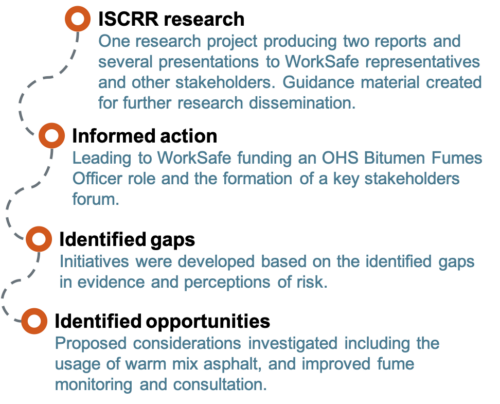Bitumen fume exposure
Bitumen fume exposure
As a result of exposure to bitumen fuming loads, WorkSafe has received reports of employees experiencing acute health effects such as dizziness, nausea and respiratory discomfort.
ISCRR carried out an evidence review to identify risk factors associated with bitumen exposure and to identify strategies to minimise health risks, as well as a desktop scan to identify information and materials related to bitumen fumes, and key informant interviews of asphalt company and union representatives.
Read ISCRR Evidence Review on Bitumen Fume Exposure here
Read ISCRR’s Environmental Scan on Bitumen Fumes here


The combined knowledge and gaps identified led to WorkSafe funding an OHS Bitumen Fumes Officer with the Australian Workers Union (AWU) to lead and guide several risk awareness and risk reduction initiatives including:
The findings from this research also informed new initiatives to reduce bitumen temperatures, thereby reducing fuming loads (Victorian Department of Transport and local municipal councils).
“ISCRR research helped identify a number of occupational health and safety gaps across the asphalt and bitumen industry. They range from temperature control of asphalt products and the emergence of recycled products into asphalt products, consultation across the industry with the introduction of new products, tracking and tracing of waste products from the industry and a standardised testing regime. Currently, up until recently, there hasn’t been one [a standardised testing regime] across the industry to test for fumes and vapours for asphalt products.”
AWU OHS Bitumen Safety Officer

In a relatively short time period, numerous impacts were achieved as a direct result of this research, and is considered an important step forward to improving the safety of road construction workers. Further impacts are anticipated in the future, and ISCRR is in discussions with AWU to develop further research communication material to aid in disseminating these findings to a wider audience.
– Dissemination and presentation of research findings to key stakeholders (WorkSafe, Victorian Department of Transport, AWU, industry interest groups)
– Policy and planning discussions (WorkSafe and Victorian Department of Transport)
– WorkSafe announcement of AWU OHS Bitumen Fumes Officer grant
– Production of guidance materials
– Informed WorkSafe policy on bitumen fumes
– Informed stakeholders on current practices and risk perceptions
– Supported site sampling and exposure measurements for workers
– WorkSafe announcement of AWU OHS Bitumen Fumes Officer grant
– Formation of key stakeholders forum
– Industry engagement and consultation
– Development of bitumen fume initiatives (Victorian Department of Transport and local municipal councils)
– Anecdotal evidence regarding improved fume monitoring
– Discussions occurring to address barriers in the industry
Under normal ambient conditions, bitumen is stable, solid and does not present any health risks. However, most bitumen applications are carried out at high temperatures between 170°C and 180°C, and heated bitumen produce ‘emissions’, which comprise a complex mixture of vapours, aerosols, gases and particulate matter.
Bitumen fume exposure has been associated with acute health effects such as eye, nose, throat and skin irritation, nausea and respiratory discomfort. As a result of exposure to fuming loads or contact with bitumen products, WorkSafe has received reports of employees experiencing acute health effects such as dizziness, nausea and respiratory discomfort. Data from the AWU survey of workers revealed that 76% of workers were concerned about the long-term effects of exposure to bitumen fumes. International Agency for Research on Cancer (IARC) determined that occupational exposures to straight-run bitumen and their emissions during road paving are ‘possibly carcinogenic to humans’ (Group 2B).